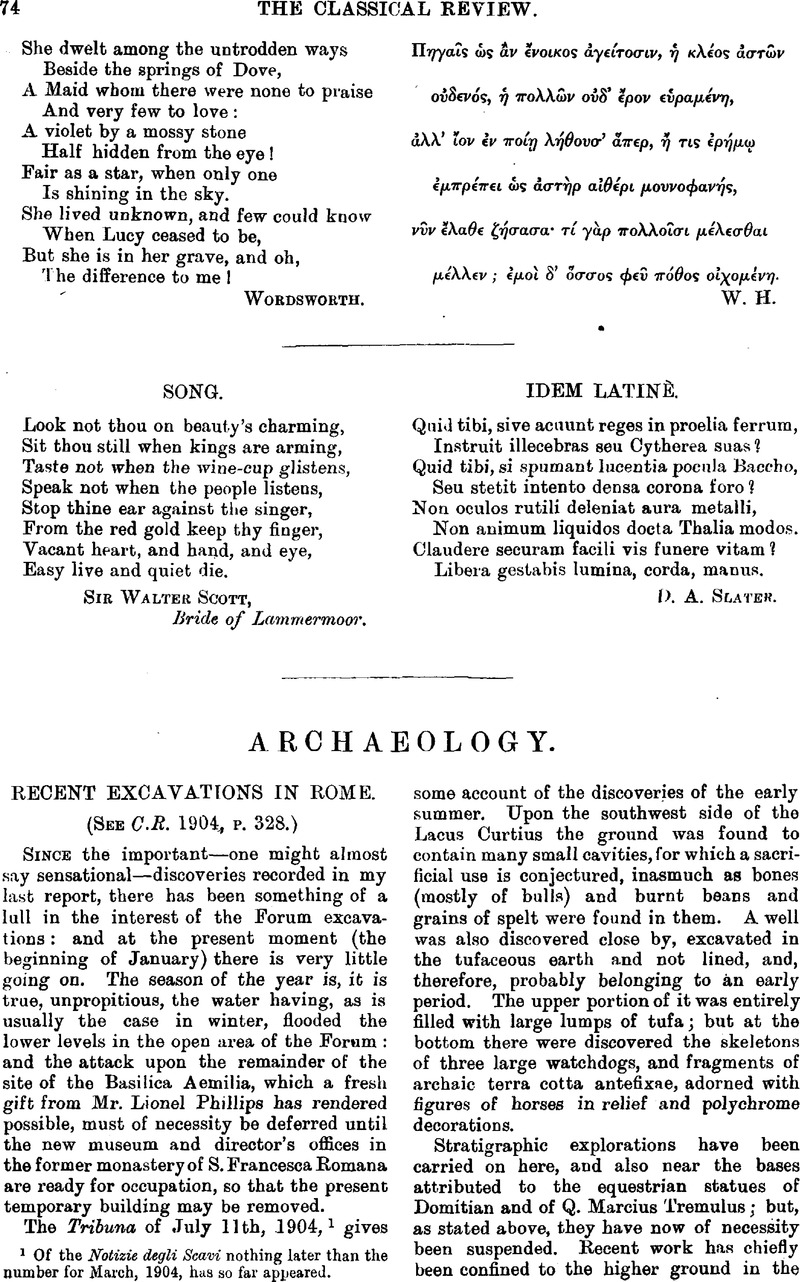Article contents
Archaeology
Published online by Cambridge University Press: 27 October 2009
Abstract

- Type
- Other
- Information
- Copyright
- Copyright © The Classical Association 1905
References
page 74 note 1 Of the Notizie degli Scavi nothing later than the number for March, 1904, has so far appeared.
page 75 note 1 This expression is generally taken to mean ‘at the beginning of the Sacra Via,’ i.e. at the end where the ascent to the Palatine is (and not at the Capitol end); but is it not possible that it may have the same meaning as Sacer Clivus in Martial i. 70. 5 iv. 78. 7 (see C.K. 1902, 336)?
page 75 note 2 In the ‘Nomenclator’ to Kiepert and Hülsen, Forma Urbis Romae Antiquae, he follows Gilbert's view: but cf. Röm. Mitt. 1902, 95 — where, as the sense shows, ‘westlich’ must be a mispriut for ‘östlich.’
page 76 note 1 In a room further to the southwest is a circular well cut in the rock: in the soil which had accumulated above it were found a dolium and an amphora, both entire.
page 76 note 2 The foundations upon which the bases of these presumed columns stood are each l·40 metre square (Comm. Boni was good enough to have them cleared in response to an enquiry from me), and in the three spaces the threshold slabs of marble still remain; cf. Platner, Topography of Ancient Rome, 318. Comm. Boni further remarks that the existence of four columns of red porphyry at the entrance from the Sacra Via (opposite to this apse) is uncertain, those which now stand there belonging to a comparatively recent restoration, and the discovery of a similar fragment below the level of the intermediate road mentioned in C.R. 1900, 239, may be an argument against the correctness of this restoration.
page 77 note 1 The five tufa steps in front of the Curia of Diocletian (which, it is generally agreed, occupies the exact site of the Curia Iulia) which correspond more or less in orientation with it, but lie at a far lower level than even the pavement of the Republican Comitium—they are lettered X in the plan in Not. Scav. 1900, 296—perhaps belonged to the northeastern enclosing wall of the Comitium (Petersen, op cit. 14).
page 77 note 2 ‘Inferior locus’ is interpreted, however, as re ferring to the level of the Comitium as distinguished from the Rostra, not to the Rostra in the wider sense as against the narrower.
page 78 note 1 Professor Petersen (p. 33, note 38) refuses to accept Richter's new theory (C.R. 1904, 140) with regard to the hemicycle which has hitherto been known as the Graecostasis. He does not attempt to meet the argument (urged long ago by Nichols, and confirmed by Richter's recent observations) that at the point of contact the hemicycle certainly seems to be earlier in date than the structure of opus quadratum in front of it. His observations with regard to the technique of the facing of the hemicycle are important: but slabs of porta santa (Iasian) marble are hardly to be described as ‘bunte Kalksteiuplatten.’
page 78 note 2 It need hardly be said that they are irreconcilable with those of Professor Studniczka (cf. C.R. 1904, 140).
page 82 note 1 In common with most Egyptological students, I adhere to the older date for the XIIth. Dynasty. The calculation, accepted by some German Egyptologists, which would bring this date down to about 1900 B.C., seems to me to be inadmissible. It is difficult to cram the XIIIth Dynasty and the Hyksos period into three centuries, and Brugsch's date still holds the field.
page 84 note 1 See Annual of the British School at Athens, 1898–99, p. 69 ff.
page 85 note 1 This fault is not peculiar to the Catalogue of Terracottas. As things are at present no visitor without official help can be certain of finding a particular vase within reasonable time.
- 2
- Cited by


